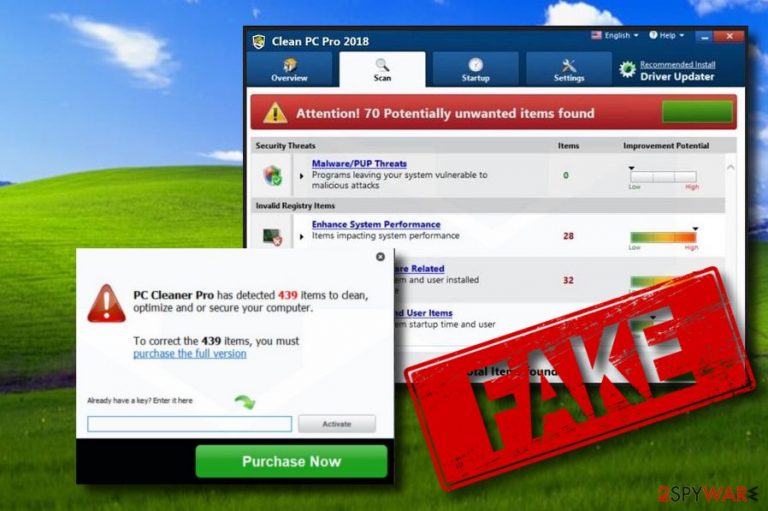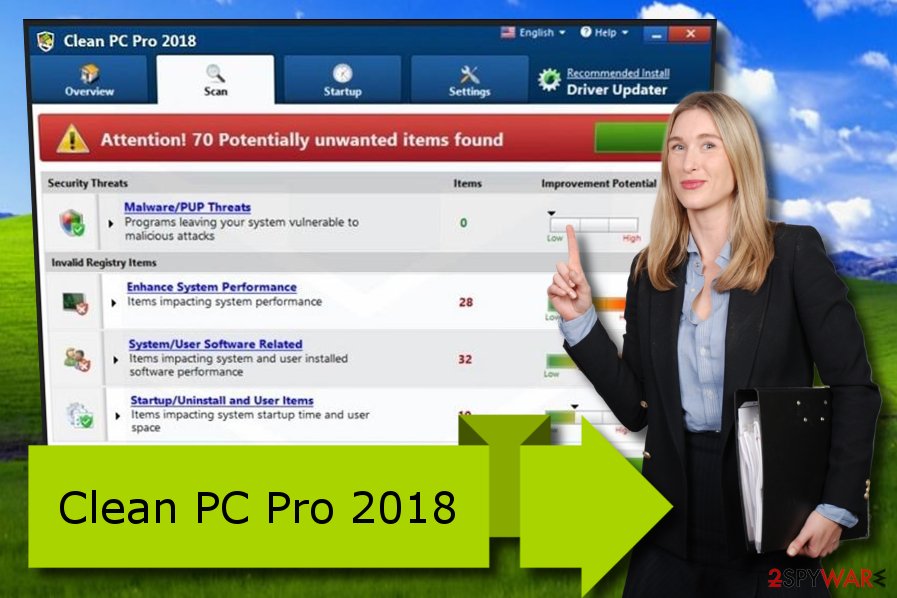Clean PC Pro 2018 (Removal Instructions) - Tutorial
Clean PC Pro 2018 Removal Guide
What is Clean PC Pro 2018?
Clean PC Pro 2018 – an unreliable program which claims to be capable of fixing infected systems but truly causes fake warnings

Clean PC Pro 2018 is a fake optimization tool which can hardly have any effect on your computer's performance. In short, this program is suited to trick users and empty their pockets. Once Clean PC Pro 2018 virus is launched on the computer, various alerts reporting about detected viruses start popping up and interrupt user’s activity. According to IT security professionals[1], the questionable software infiltrates into your system by using social engineering and similar techniques, so make sure you are careful enough while surfing the Internet.
| Name | Clean PC Pro 2018 |
|---|---|
| Type | Adware/scareware[2] |
| Danger level | Medium. Computer components remain safe, but you can lose your money and reveal your credit card details to unknown developers |
| Purpose | Tricks users into buying the full version |
| Similarities | Total System Care, PC Cleaner Pro, and others |
| Distribution | Comes bundled with free software or uses its official website |
| Elimination | You can delete this PUP from the computer system with the help of FortectIntego |
Clean PC Pro 2018 starts running its scanners right after entering the system. No matter how convincing these messages seem, notice that all these scan reports are false and are displayed for convincing people that their systems are in danger. The main thing the owners of this program are seeking for is to make victims buy the full its version. However, paying for optimization tools is not recommended as there is a high risk that the app is reporting about invented viruses and errors. Additionally, it stops showing its warning right after you buy its license.
Fortunately, this unreliable fixing tool does not harm your computer in any way. It just annoys its victims in a few ways:
- Showing false warnings right after imitating a full system scan;
- Providing intrusive ads while browsing the Internet;
- Can install other harmful/unwanted components.
After hearing all these details about this optimization program, we strongly advise you to remove Clean PC Pro 2018. It is known that this tool is closely related to other similar apps, such as Total System Care which acts identically. Make sure you get rid of all related components when trying to fix the system entirely.
No matter how many times you have cleaned your PC before, scan results displayed by this program are always the same: thousands of threats and potentially unwanted items are “attacking” your computer. However, this misleading app is the only one that should be eliminated. Either for Clean PC Pro 2018 removal or for making sure that your computer is totally fine, we recommend using an anti-malware tool[3] such as FortectIntego.

Keep your PC away from unreliable programs
Even if you can download/install fake optimization tools from their official sites and direct links, such tools typically turn out to be a result of software bundling. Unreliable programs can get into your computer system when downloading free software by skipping or rushing the whole process. You have to make some effort if you want to protect your system from such kind of damage.
First of all, if you have visited a site which promotes an unreliable cleaning tool – leave it. DO NOT click on any links provides there as one simple click can start the installation of unwanted software right away.
To continue, try to download/install your software only from trusted sources. Avoid using secondary installers. Although, if you do use one – carefully monitor all download steps that are displayed through the whole process. You can go through them by selecting Custom/Advanced settings.
Furthermore, having an anti-malware tool running on your computer will increase the safety level. If it is always kept up-to-date, the tool will do system scans regularly and warn you if there are any threats found and if there are – how to fix them quickly and safely.
Anti-malware is the quickest way to get rid of Clean PC Pro 2018
To remove Clean PC Pro 2018, you need to go to the Task Manager and uninstall it from there. Make sure you carefully run thru the list of programs just to make sure that all suspicious programs from unknown developers are eliminated.
For checking your computer for malicious files and errors, you can always use programs that we provided below. These tools will detect the cyber threats by scanning the whole system. The removal procedure should take no longer than a few minutes.
When Clean PC Pro 2018 removal is finished, you should also reset your web browsers, just to make sure that there are adware-free. Ads that keep appearing on your screen while browsing the Internet is a clear sign showing that PUPs are also hiding on your system.
You may remove virus damage with a help of FortectIntego. SpyHunter 5Combo Cleaner and Malwarebytes are recommended to detect potentially unwanted programs and viruses with all their files and registry entries that are related to them.
Getting rid of Clean PC Pro 2018. Follow these steps
Uninstall from Windows
If you want to uninstall Clean PC Pro 2018 from Windows operating system, carefully follow these guidelines:
Instructions for Windows 10/8 machines:
- Enter Control Panel into Windows search box and hit Enter or click on the search result.
- Under Programs, select Uninstall a program.

- From the list, find the entry of the suspicious program.
- Right-click on the application and select Uninstall.
- If User Account Control shows up, click Yes.
- Wait till uninstallation process is complete and click OK.

If you are Windows 7/XP user, proceed with the following instructions:
- Click on Windows Start > Control Panel located on the right pane (if you are Windows XP user, click on Add/Remove Programs).
- In Control Panel, select Programs > Uninstall a program.

- Pick the unwanted application by clicking on it once.
- At the top, click Uninstall/Change.
- In the confirmation prompt, pick Yes.
- Click OK once the removal process is finished.
Delete from macOS
Remove items from Applications folder:
- From the menu bar, select Go > Applications.
- In the Applications folder, look for all related entries.
- Click on the app and drag it to Trash (or right-click and pick Move to Trash)

To fully remove an unwanted app, you need to access Application Support, LaunchAgents, and LaunchDaemons folders and delete relevant files:
- Select Go > Go to Folder.
- Enter /Library/Application Support and click Go or press Enter.
- In the Application Support folder, look for any dubious entries and then delete them.
- Now enter /Library/LaunchAgents and /Library/LaunchDaemons folders the same way and terminate all the related .plist files.

Remove from Microsoft Edge
Delete unwanted extensions from MS Edge:
- Select Menu (three horizontal dots at the top-right of the browser window) and pick Extensions.
- From the list, pick the extension and click on the Gear icon.
- Click on Uninstall at the bottom.

Clear cookies and other browser data:
- Click on the Menu (three horizontal dots at the top-right of the browser window) and select Privacy & security.
- Under Clear browsing data, pick Choose what to clear.
- Select everything (apart from passwords, although you might want to include Media licenses as well, if applicable) and click on Clear.

Restore new tab and homepage settings:
- Click the menu icon and choose Settings.
- Then find On startup section.
- Click Disable if you found any suspicious domain.
Reset MS Edge if the above steps did not work:
- Press on Ctrl + Shift + Esc to open Task Manager.
- Click on More details arrow at the bottom of the window.
- Select Details tab.
- Now scroll down and locate every entry with Microsoft Edge name in it. Right-click on each of them and select End Task to stop MS Edge from running.

If this solution failed to help you, you need to use an advanced Edge reset method. Note that you need to backup your data before proceeding.
- Find the following folder on your computer: C:\\Users\\%username%\\AppData\\Local\\Packages\\Microsoft.MicrosoftEdge_8wekyb3d8bbwe.
- Press Ctrl + A on your keyboard to select all folders.
- Right-click on them and pick Delete

- Now right-click on the Start button and pick Windows PowerShell (Admin).
- When the new window opens, copy and paste the following command, and then press Enter:
Get-AppXPackage -AllUsers -Name Microsoft.MicrosoftEdge | Foreach {Add-AppxPackage -DisableDevelopmentMode -Register “$($_.InstallLocation)\\AppXManifest.xml” -Verbose

Instructions for Chromium-based Edge
Delete extensions from MS Edge (Chromium):
- Open Edge and click select Settings > Extensions.
- Delete unwanted extensions by clicking Remove.

Clear cache and site data:
- Click on Menu and go to Settings.
- Select Privacy, search and services.
- Under Clear browsing data, pick Choose what to clear.
- Under Time range, pick All time.
- Select Clear now.

Reset Chromium-based MS Edge:
- Click on Menu and select Settings.
- On the left side, pick Reset settings.
- Select Restore settings to their default values.
- Confirm with Reset.

Remove from Mozilla Firefox (FF)
Remove dangerous extensions:
- Open Mozilla Firefox browser and click on the Menu (three horizontal lines at the top-right of the window).
- Select Add-ons.
- In here, select unwanted plugin and click Remove.

Reset the homepage:
- Click three horizontal lines at the top right corner to open the menu.
- Choose Options.
- Under Home options, enter your preferred site that will open every time you newly open the Mozilla Firefox.
Clear cookies and site data:
- Click Menu and pick Settings.
- Go to Privacy & Security section.
- Scroll down to locate Cookies and Site Data.
- Click on Clear Data…
- Select Cookies and Site Data, as well as Cached Web Content and press Clear.

Reset Mozilla Firefox
If clearing the browser as explained above did not help, reset Mozilla Firefox:
- Open Mozilla Firefox browser and click the Menu.
- Go to Help and then choose Troubleshooting Information.

- Under Give Firefox a tune up section, click on Refresh Firefox…
- Once the pop-up shows up, confirm the action by pressing on Refresh Firefox.

Remove from Google Chrome
Get rid of annoying content which could have been brought by this fake optimization tool by resetting your Google Chrome browser:
Delete malicious extensions from Google Chrome:
- Open Google Chrome, click on the Menu (three vertical dots at the top-right corner) and select More tools > Extensions.
- In the newly opened window, you will see all the installed extensions. Uninstall all the suspicious plugins that might be related to the unwanted program by clicking Remove.

Clear cache and web data from Chrome:
- Click on Menu and pick Settings.
- Under Privacy and security, select Clear browsing data.
- Select Browsing history, Cookies and other site data, as well as Cached images and files.
- Click Clear data.

Change your homepage:
- Click menu and choose Settings.
- Look for a suspicious site in the On startup section.
- Click on Open a specific or set of pages and click on three dots to find the Remove option.
Reset Google Chrome:
If the previous methods did not help you, reset Google Chrome to eliminate all the unwanted components:
- Click on Menu and select Settings.
- In the Settings, scroll down and click Advanced.
- Scroll down and locate Reset and clean up section.
- Now click Restore settings to their original defaults.
- Confirm with Reset settings.

Delete from Safari
Remove unwanted extensions from Safari:
- Click Safari > Preferences…
- In the new window, pick Extensions.
- Select the unwanted extension and select Uninstall.

Clear cookies and other website data from Safari:
- Click Safari > Clear History…
- From the drop-down menu under Clear, pick all history.
- Confirm with Clear History.

Reset Safari if the above-mentioned steps did not help you:
- Click Safari > Preferences…
- Go to Advanced tab.
- Tick the Show Develop menu in menu bar.
- From the menu bar, click Develop, and then select Empty Caches.

After uninstalling this potentially unwanted program (PUP) and fixing each of your web browsers, we recommend you to scan your PC system with a reputable anti-spyware. This will help you to get rid of Clean PC Pro 2018 registry traces and will also identify related parasites or possible malware infections on your computer. For that you can use our top-rated malware remover: FortectIntego, SpyHunter 5Combo Cleaner or Malwarebytes.
How to prevent from getting system tools
Protect your privacy – employ a VPN
There are several ways how to make your online time more private – you can access an incognito tab. However, there is no secret that even in this mode, you are tracked for advertising purposes. There is a way to add an extra layer of protection and create a completely anonymous web browsing practice with the help of Private Internet Access VPN. This software reroutes traffic through different servers, thus leaving your IP address and geolocation in disguise. Besides, it is based on a strict no-log policy, meaning that no data will be recorded, leaked, and available for both first and third parties. The combination of a secure web browser and Private Internet Access VPN will let you browse the Internet without a feeling of being spied or targeted by criminals.
No backups? No problem. Use a data recovery tool
If you wonder how data loss can occur, you should not look any further for answers – human errors, malware attacks, hardware failures, power cuts, natural disasters, or even simple negligence. In some cases, lost files are extremely important, and many straight out panic when such an unfortunate course of events happen. Due to this, you should always ensure that you prepare proper data backups on a regular basis.
If you were caught by surprise and did not have any backups to restore your files from, not everything is lost. Data Recovery Pro is one of the leading file recovery solutions you can find on the market – it is likely to restore even lost emails or data located on an external device.
- ^ Losvirus ES. losvirus.es. Professional security advisors.
- ^ Scareware. Wikipedia. The free encyclopedia.
- ^ Margaret Rouse. Definition of antimalware (anti-malware). Search security. Tech target.
